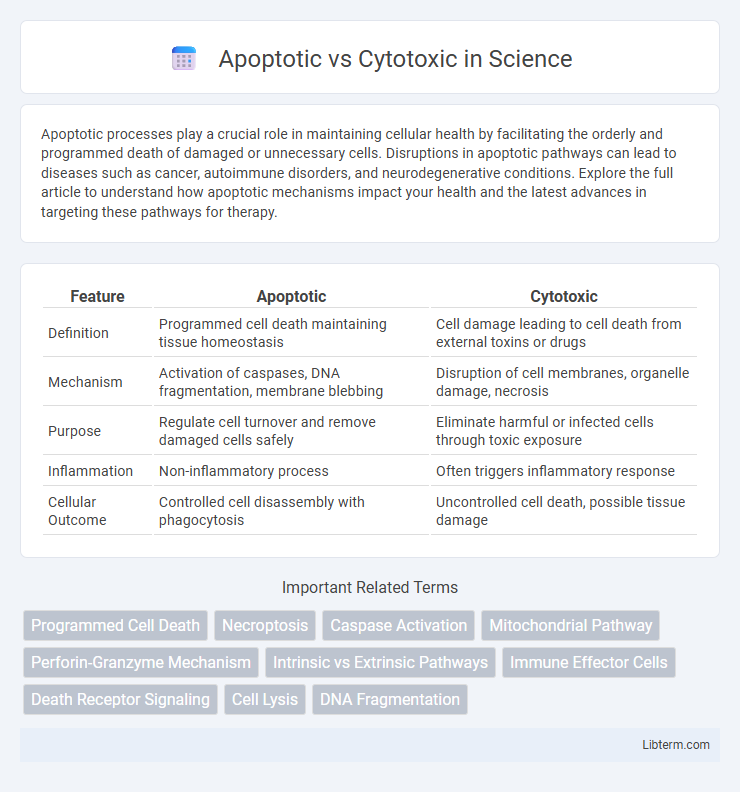Apoptotic processes play a crucial role in maintaining cellular health by facilitating the orderly and programmed death of damaged or unnecessary cells. Disruptions in apoptotic pathways can lead to diseases such as cancer, autoimmune disorders, and neurodegenerative conditions. Explore the full article to understand how apoptotic mechanisms impact your health and the latest advances in targeting these pathways for therapy.
Table of Comparison
| Feature | Apoptotic | Cytotoxic |
|---|---|---|
| Definition | Programmed cell death maintaining tissue homeostasis | Cell damage leading to cell death from external toxins or drugs |
| Mechanism | Activation of caspases, DNA fragmentation, membrane blebbing | Disruption of cell membranes, organelle damage, necrosis |
| Purpose | Regulate cell turnover and remove damaged cells safely | Eliminate harmful or infected cells through toxic exposure |
| Inflammation | Non-inflammatory process | Often triggers inflammatory response |
| Cellular Outcome | Controlled cell disassembly with phagocytosis | Uncontrolled cell death, possible tissue damage |
Introduction to Apoptotic and Cytotoxic Mechanisms
Apoptotic mechanisms involve programmed cell death characterized by energy-dependent processes such as DNA fragmentation, membrane blebbing, and caspase activation, maintaining tissue homeostasis without inducing inflammation. Cytotoxic mechanisms result from external agents or immune responses causing cell damage or necrosis, often triggering inflammatory responses due to uncontrolled cell lysis. Understanding the molecular pathways of apoptosis, including intrinsic mitochondrial signals and extrinsic death receptor pathways, contrasts with the broader, often nonspecific damage caused by cytotoxic factors.
Defining Apoptosis: Programmed Cell Death
Apoptosis is a highly regulated process of programmed cell death essential for maintaining cellular homeostasis and eliminating damaged or unnecessary cells without triggering inflammation. This mechanism involves a cascade of molecular events, including caspase activation, DNA fragmentation, and membrane blebbing, distinguishing it from cytotoxic cell death, which causes direct and often uncontrolled cellular damage. Understanding apoptosis is crucial for developing therapies targeting cancer, autoimmune disorders, and neurodegenerative diseases, where dysregulated cell death plays a significant role.
Understanding Cytotoxicity: Cell-Killing Processes
Cytotoxicity refers to the capacity of certain substances or immune cells to kill or damage cells, often by disrupting cell membranes, interfering with metabolic processes, or inducing oxidative stress. Apoptotic cell death involves a regulated, programmed process where cells systematically dismantle themselves without releasing harmful substances, maintaining tissue homeostasis. Understanding cytotoxic mechanisms is crucial for developing therapies that selectively target diseased cells while minimizing harm to healthy tissues.
Molecular Pathways: Apoptosis versus Cytotoxicity
Apoptosis primarily involves intrinsic and extrinsic molecular pathways that activate caspases leading to programmed cell death without eliciting inflammation, characterized by mitochondrial outer membrane permeabilization and death receptor signaling. Cytotoxicity, often mediated by immune cells like cytotoxic T lymphocytes and natural killer cells, employs granzyme and perforin pathways to induce target cell lysis, resulting in uncontrolled cell death and potential inflammatory responses. The distinction in molecular pathways highlights apoptosis as a regulated, non-inflammatory process while cytotoxicity triggers direct cell membrane disruption and immune-mediated damage.
Key Triggers for Apoptotic and Cytotoxic Responses
Apoptotic responses are primarily triggered by intrinsic signals such as DNA damage, oxidative stress, and mitochondrial dysfunction, or extrinsic signals like death receptor activation from ligands such as FasL and TNF-alpha. Cytotoxic responses are induced by external factors including toxins, chemotherapeutic agents, and immune-mediated cell attacks involving perforin and granzymes release from cytotoxic T cells. Understanding the molecular pathways activated by these triggers, including caspase cascade initiation in apoptosis and membrane disruption in cytotoxicity, is crucial for targeted therapeutic interventions.
Cellular Markers: Distinguishing Apoptotic and Cytotoxic Cells
Apoptotic cells exhibit increased Annexin V binding due to phosphatidylserine externalization and elevated caspase-3 activity, which serve as key markers for programmed cell death. Cytotoxic cells, such as activated cytotoxic T lymphocytes and natural killer cells, are characterized by granzyme B and perforin expression, facilitating target cell lysis. Differential detection of these markers allows precise discrimination between apoptosis-induced cell death and immune cell-mediated cytotoxicity in tissue samples.
Therapeutic Implications in Cancer Treatment
Apoptotic therapies trigger programmed cell death pathways, selectively eliminating cancer cells while minimizing damage to healthy tissue, enhancing treatment specificity and reducing side effects. Cytotoxic agents, such as chemotherapy, induce cell death through direct cellular damage, often leading to broader toxicity and resistance issues. Combining apoptotic mechanisms with cytotoxic drugs holds promise for overcoming resistance and improving therapeutic outcomes in cancer treatment.
Apoptotic Agents vs Cytotoxic Drugs: Mechanistic Differences
Apoptotic agents trigger programmed cell death by activating intrinsic or extrinsic signaling pathways, ensuring controlled elimination of damaged or unwanted cells without provoking inflammation. Cytotoxic drugs, by contrast, induce cell death primarily through direct damage to DNA or disruption of mitotic processes, which can lead to uncontrolled necrosis and collateral tissue damage. Understanding these mechanistic differences is critical for optimizing therapeutic strategies in cancer treatment, as apoptotic agents often offer greater specificity and reduced systemic toxicity compared to traditional cytotoxic drugs.
Advantages and Limitations of Each Mechanism
Apoptotic mechanisms enable controlled cell death, minimizing inflammation and tissue damage, which is advantageous in maintaining homeostasis and treating diseases like cancer; however, their reliance on energy and specific signaling pathways limits effectiveness in nutrient-deprived or resistant cells. Cytotoxic mechanisms induce rapid and direct cell destruction, offering potent action against diverse cell types, but they often provoke inflammation and collateral damage, posing challenges in precision therapies. Balancing these mechanisms is crucial for optimizing therapeutic outcomes in oncology and autoimmune disorder treatments.
Future Directions in Apoptotic and Cytotoxic Research
Future directions in apoptotic and cytotoxic research emphasize the development of targeted therapies that selectively induce apoptosis in cancer cells while minimizing damage to healthy tissues. Advances in molecular profiling and single-cell analysis are driving personalized medicine approaches to optimize cytotoxic drug efficacy with reduced side effects. Emerging technologies such as CRISPR gene editing and high-throughput screening are poised to identify novel apoptotic pathways and cytotoxic agents, enhancing therapeutic precision and overcoming drug resistance.
Apoptotic Infographic

 libterm.com
libterm.com